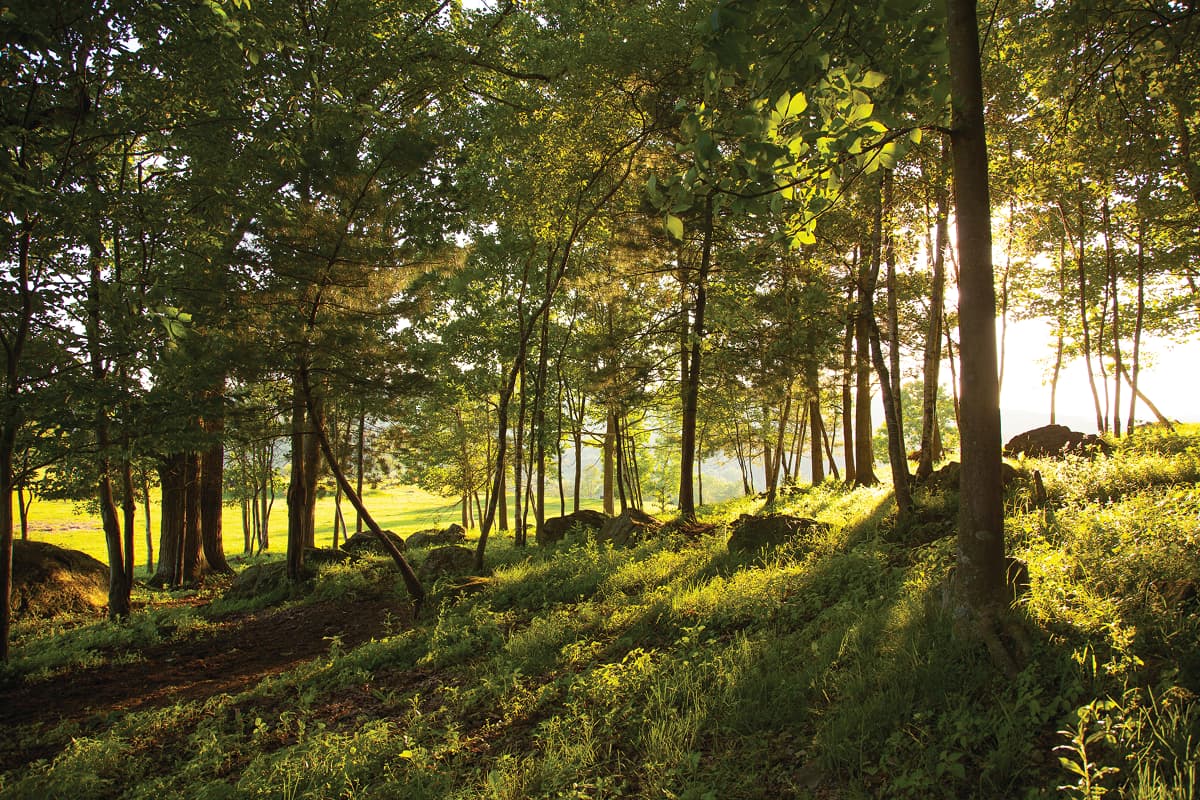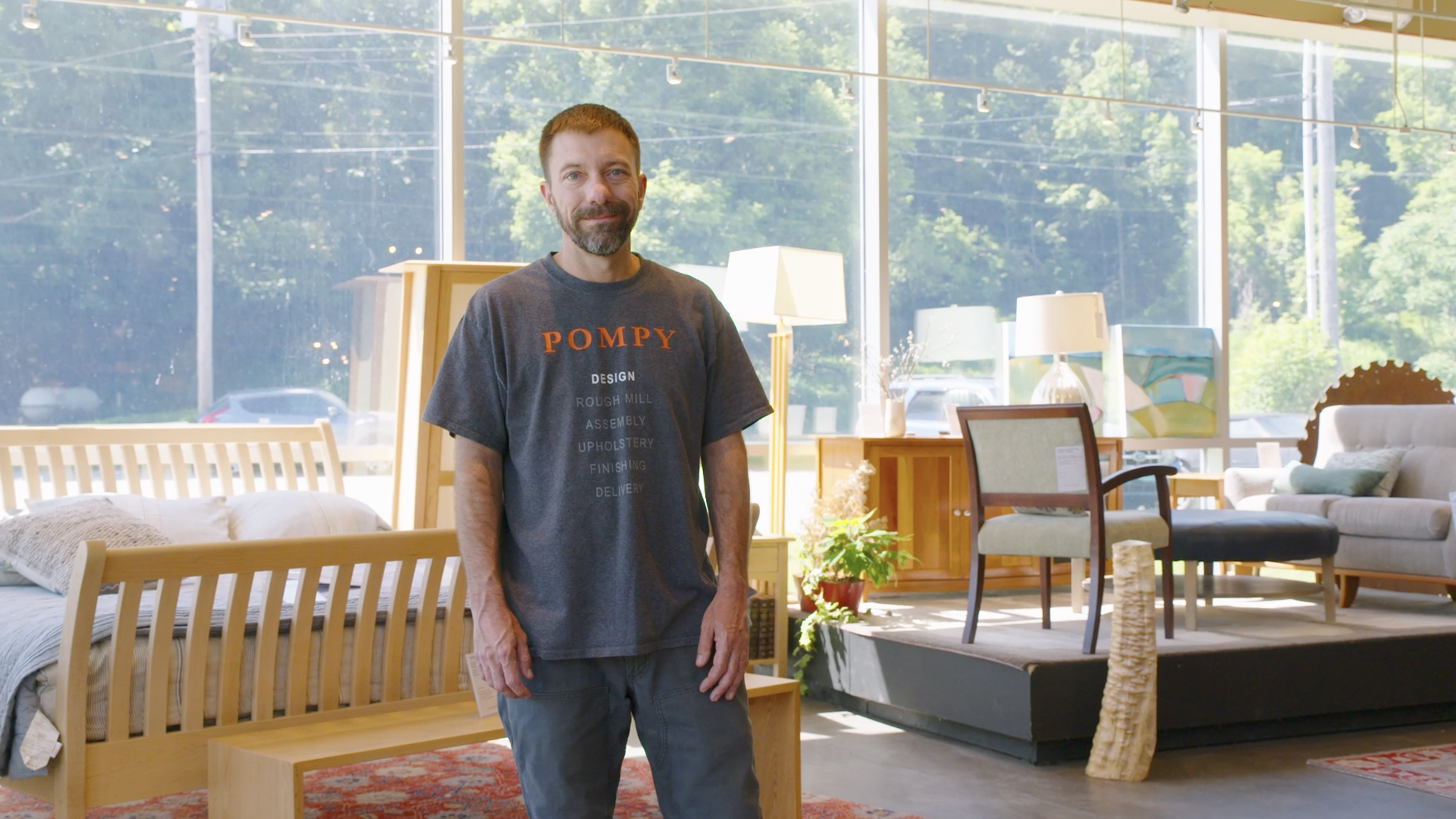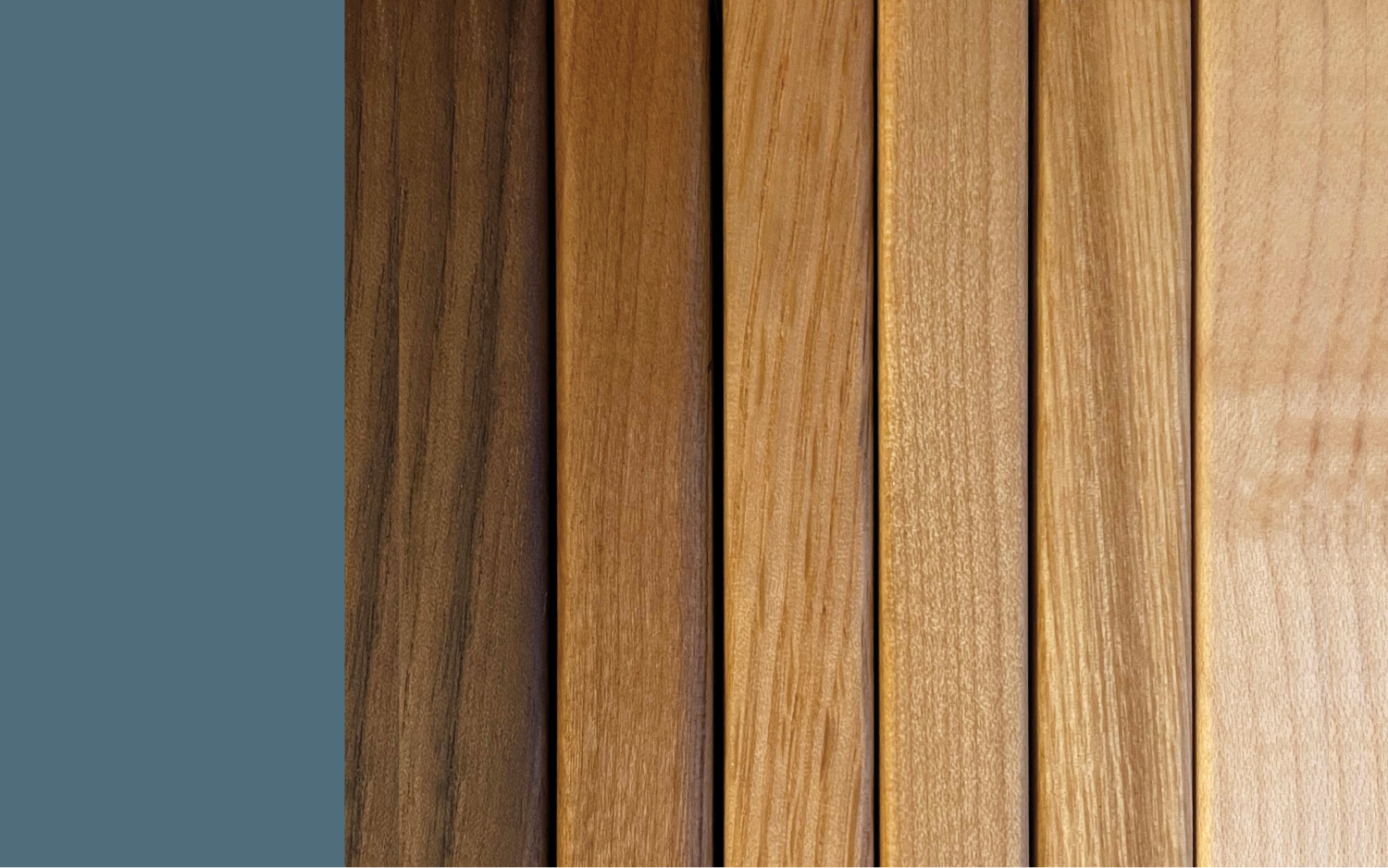
From Wood to Syrup: A Conversation with Lucas Stepno
Craft, Tradition, and Vermont’s Sugar Maples
At Pompanoosuc Mills, craftsmanship is at the heart of everything we do—carefully shaping raw materials into something beautiful, lasting, and deeply connected to Vermont. That same spirit exists in the time-honored tradition of maple sugaring, where patience, skill, and nature’s rhythm come together to create something truly special.
Few people understand this connection better than Lucas Stepno, our Head of Custom Designs. With over 25 years at Pompanoosuc Mills, Lucas has spent his career designing and building furniture from the very same trees that give Vermont its most beloved natural treasure: maple syrup. When he’s not in our workshop, you’ll find him in the sugarbush, carrying on the tradition of sugaring with his family and friends.
We sat down with Lucas to talk about his two great passions—fine woodworking and maple sugaring—and what it means to be part of Vermont’s rich tradition of craftsmanship and sustainability.
Sugaring and Craftsmanship: A Life in Vermont’s Woods
-1.jpeg?width=1024&height=768&name=Image%20(7)-1.jpeg) Q: You’ve spent over 25 years designing custom furniture for Pompanoosuc Mills. What drew you to woodworking, and how does your love of working with wood connect to your passion for maple sugaring?
Q: You’ve spent over 25 years designing custom furniture for Pompanoosuc Mills. What drew you to woodworking, and how does your love of working with wood connect to your passion for maple sugaring?
A: After working as a college intern at a design firm in Boston that produced a lot of plastic products, that were destined for a landfill someday, I knew I wanted to work with a renewable resource that is more environmentally friendly like wood. My connection between wood working and maple sugaring is simple, it’s the trees.
Q: Maple syrup and fine furniture both start with Vermont’s forests. How do you see the connection between what we do at Pompanoosuc Mills and the craft of sugaring?
A: Well, we have a lot of forest here in the northeast, so we’re both just making the very best out of what we have.
Q: Do you think there’s a shared craftsmanship between making maple syrup and making fine furniture?
A: Absolutely. We both have the utmost respect for the raw materials and as with any smart business, we need to be as efficient as possible with them.
The Magic of Sugaring Season
-2.jpeg?width=1200&length=1200&name=Image%20(10)-2.jpeg)
-2.jpg?width=1200&length=1200&name=Image%20(15)-2.jpg)
-2.jpeg?width=1200&length=1200&name=Image%20(8)-2.jpeg)
Q: How long have you been sugaring, and what first got you into it?
A: I’ve been sugaring for as long as I can remember, I used to help my dad with our 10-15 sap buckets, and he just boiled it in a big pot on the kitchen stove. When I bought my 1st house, the neighbors had a small sugar house with 350 taps, and I helped them for years just for fun and knowledge. Now I help a good family friend with around 7000 taps.
Q: Can you describe that feeling when the first sap of the season starts to run? Is there a moment that signals to you that sugaring season has begun?
A: It’s certainly an exciting time of year, and by late February I think everyone is ready for spring. We watch the weather forecast closely this time of year, waiting for those warming trends, and the snow around the trees starts to skirt out, or pull away, when the sap starts running.
Q: Vermont winters can be long and harsh. Does sugaring feel like a sign of renewal, like the first real step into spring?
A : Yes. And since we must work all year long maintaining the sugar bush sap lines and systems, we get our reward when we boil and finally make syrup in the spring.
Q: Do you have a favorite memory or story from past sugaring seasons? Maybe a funny mishap or a particularly rewarding moment?
A: We’ve upgraded our arch a few times over the years, and one time we used my truck and trailer to pick it up, and I backed the trailer into a very tricky spot on the first try, earning the rewarding title of professional trailer backer upper.
Q: Sugaring is often a community effort. What’s the atmosphere like when you and your fellow sugarmakers are gathered around the evaporator, tending the boil?
A: It’s a fun and relaxed environment at the sugar house, that at any moment can quickly escalate into complete and utter sticky chaos when we’re boiling.
The Flavor and Character of Vermont Maple Syrup
Q: Vermont maple syrup comes in different grades. Can you explain the differences and what makes each one unique?

Golden Color with Delicate Taste
Usually made at the beginning of the new maple season, this syrup was known once graded as Fancy. Subtle maple flavor is best appreciated when used on pancakes or waffles or paired with rich dairy items like yogurt or vanilla ice cream. Try it over Greek yogurt or for a simple but elegant dessert, simply pour this grade of Vermont syrup over vanilla ice cream.

Amber Color with Rich Taste
Usually made about mid-season and often seems to be the most popular for all-around use. Full of characteristic maple flavor, this syrup is equally as good over waffles as it is in salad dressings, cocktails, or in a maple-sweetened barbecue sauce. If you're only going to have one grade of Vermont maple syrup in your kitchen, make it Amber Color with Rich Taste.

Dark Color with Robust Taste
As the maple season progresses, the syrup darkens in color and develops a more robust maple flavor. Good for all-around use, its hearty flavor is a great choice for all kinds of recipes. Pour over baked apples or squash, use as a glaze for meats and vegetables, or sweeten baked goods. This grade pairs well with smoky and spicy flavors like chipotle peppers, sriracha, or bourbon.

Very Dark Color with Strong Taste
Produced at the end of the season, it’s perfect for cooking and baking. When you need a strong maple flavor in a bread or cookie, ice cream, or barbecue sauce, this is the grade of choice.
Q: Do you have a favorite grade of syrup? What do you love about it, and how do you like to enjoy it?
A: My crew is going to razz me for not saying dark, but I prefer fancy for sipping, and I use a lot of amber in my tea and on my pancakes. I do like dark for cooking though.
Q: What’s your favorite way to use maple syrup? Any must-try recipes or traditions?
A: It’s a great substitute for granulated sugar in almost any cooking recipe, but my favorite use is probably in my slow cooked pork ribs recipe, just pour some syrup on top with your bbq sauce when you seal them up for the last hour in the smoker.
The Sugar Maple: A Vermont Icon
Q: The sugar maple gives us syrup in the spring and spectacular foliage in the fall. As someone who works with this wood every day, what makes sugar maple special in both forms?
A: I guess it’s the versatility of the maple tree, it’s whole life we gather sap from it and make fine syrup, then when it’s gone, we make it into fine furniture.
Q: Sugar maple is a prized hardwood—strong, durable, and full of character. What do you love most about working with it as a furniture maker?
A: It’s the hardest wood we have, so it makes sense to use it for something such as a tabletop, since there will be less dents and scratches in it over time. But what I love most are some of the beautiful exotic grain varieties, such as quilted, curly, birds eye, and spalted maple.
Q: Maple wood has such striking grain and variation. Do you see a parallel between the uniqueness of each tree and the uniqueness of custom furniture design?
A: When I’m tapping the trees during the wintertime, I must evaluate each tree individually, considering factors like sun exposure, existing tap holes from past years, and grain integrity. When I’m designing custom furniture, I also evaluate each order individually, making sure the finished product is going to meet that customer’s particular needs.
Q: Just as sugaring requires sustainable forest management, Pompanoosuc Mills is committed to responsible sourcing of hardwoods. How important is sustainability in both sugaring and woodworking, and how do we ensure Vermont’s forests thrive for future generations?
A: Sustainability is the most important factor for both sugaring and woodworking, good forest management also benefits wildlife habitat, carbon sequestration, biodiversity, forest health, and water quality.
Final Thoughts
Q: If someone were experiencing Vermont maple syrup for the first time, what would you want them to know or appreciate?
A: Vermont consistently leads the United States in maple syrup production, in 2022 we had a record year producing over 2.55 million gallons of maple syrup. The soil composition, climate, and altitude of Vermont contribute to a distinct flavor profile that sets its maple syrup apart.
Q: If you had to describe sugaring—and Vermont’s connection to the sugar maple—in just a few words, what would they be?
A: I’m just proud to be part of such a long-standing local tradition.
Bringing It All Together
Lucas’s perspective reminds us that Vermont’s sugar maples offer more than just their sweetness—they are a cornerstone of our landscape, economy, and way of life. From the syrup we pour on our pancakes to the timeless furniture that fills our homes, the sugar maple is a symbol of strength, resilience, and beauty—just like the people of Vermont.
-2.jpeg?width=1024&height=769&name=Image%20(11)-2.jpeg)


